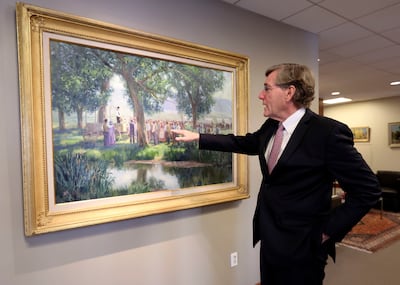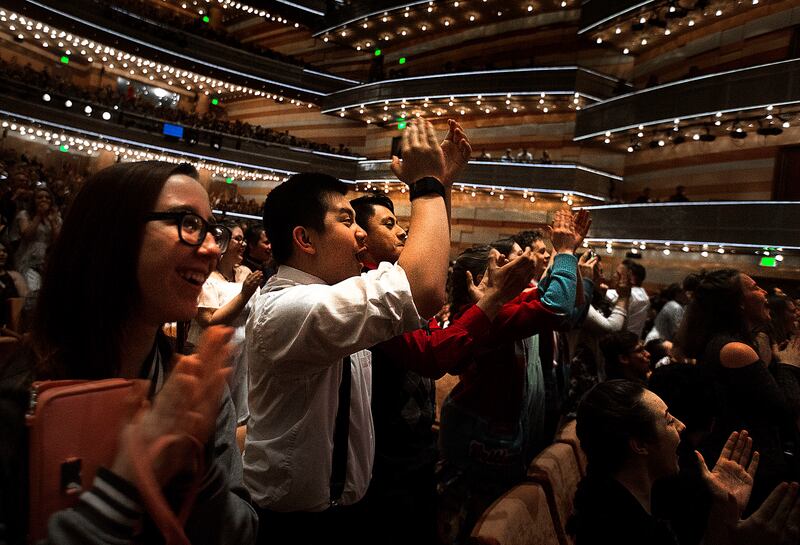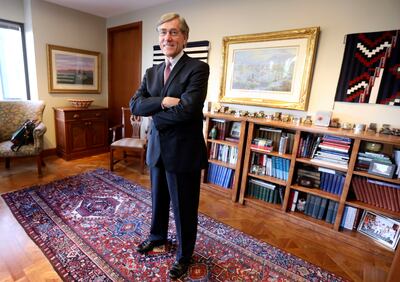SALT LAKE CITY — President and CEO of Zions Bank Scott Anderson remembers his mother hoping one specific thing for him as a child: She wanted him to learn to play an instrument.
“She had me take the violin, she had me take piano, she had me take voice lessons, and unfortunately, I didn’t have talent to make it in any of those areas,” Anderson said with a laugh.
Although Anderson’s skillset pointed him toward a life in business rather than a life in the arts, his mother’s persistence in exposing him to the arts has nevertheless had a lasting impact.
“It did teach me to appreciate (art) and I’m forever grateful to her for that,” Anderson said in an interview with the Deseret News.

That appreciation for the arts shines through in the work Anderson does at Zions Bank and in the company’s commitment to Utah’s arts scene, which is the basis for the company being named a recipient of Americans for the Arts’ BCA 10 Award.
“Every year, Americans for the Arts, through its Business Committee for the Arts (BCA) program, recognizes 10 businesses of all sizes for their exceptional involvement with the arts that enriches the workplace, education and the community,” according to americansforthearts.org. “These companies set the standard for excellence and serve as role models for others to follow.”
The 10 honorees show commitment to the arts through grants, partnerships, volunteer programs, sponsorships and board membership, according to the website. Zions Bank’s arts initiatives vary widely — from the bank’s collection of more than 3,800 original works of art by regional artists, to the company’s support of local arts organizations, to its annual art shows — and this year marks Zions Bank’s second time receiving the award. The company was previously honored in 2008.
“So I’m very honored and appreciative of this recognition,” said Anderson, who will travel to New York City to accept the award for Zions Bank on Oct. 2. “We recognize that (the arts) enriches not only our community but it enriches our workplace and our employees.”
The Deseret News spoke to Anderson about the award, Zions Bank’s involvement in the arts and the state of the arts in Utah.
This interview has been edited for clarity and length.
Deseret News: As president and CEO of Zions Bank, how does it feel for the company to receive this award?
Scott Anderson: I am so pleased and honored that the BCA would recognize Zions. … I truly believe (it is because) part of our guiding principles is we want to create value for our customers and for our communities and our shareholders and our employees and that (supporting the arts) is part of that endeavor. … As we create value in the community, we create economic prosperity and that creates cultural prosperity and everyone benefits. I believe that when the arts and business work together, creativity flourishes and we enjoy a better life.
DN: Zions Bank supports the arts in many ways, but is there one of those ways that is something that you are particularly passionate about or proud of?

SA: I think there are a couple of things that I’m particularly proud of and this year, one of them is we participated in helping fund the student program for “Hamilton,” which allowed high school students from across the state to come (see the show). … When you met and saw this audience of high school students from literally across the state, from White Horse High School in Montezuma Creek and in Kanab and in Salt Lake City and Brigham City, it was just amazing. Here they were, not only watching this performance but participating and sharing what they had done, and I thought it was just exciting to see this rebirth of the American spirit and the creative thinking. Who would have thought they were enjoying a musical about the founding of a national bank? I mean, that was rewarding to me and I thought that was terrific. …
(Another) thing that I would point out is we sponsor art shows. We do one in Boise, we do one in Salt Lake and we do one in Provo, in fact our art show in Salt Lake will happen on Nov. 2, and the one here will probably get about six to seven thousand people come through. We’ll have over 60 artists showing their works … (and) people can walk through, they can meet with the artists, they can see their work, they can buy the art, they can commission the art … and if they buy the art, 100 percent goes to the artist. …
A third example I would give is we’ve been involved in helping the Native American Navajo weavers weave their baskets and sell their baskets. We were helpful in getting the Natural History Museum of Utah to acquire the modern basket collection of the Twin Rocks Trading Post, and in fact, the first exhibit at the new Museum of Natural History was an exhibit of these baskets, which is probably the best in the world of modern Navajo weaving. The thing that excites me about this is that this is a real art form and when someone sits down to weave a basket, it’s not something that they do in a few minutes. Most of them go out and gather the sumac, they process it, they split it, they soak it, they get the dye, they dye it and then as they weave it, they don’t have a pattern that they draw like you would use if you’re making a sweater, this is all in their heads and it is incredible when you see how they weave. … They come up with incredible pieces of work.

DN: In what ways do you think individuals in the state can contribute to the arts?
SA: We should take pride in teaching our children about the arts, having them take piano lessons and violin lessons and painting lessons and dancing lessons so that they learn how to appreciate the arts and then to develop their talents. … I think as parents, as adults interested in the youth that we can make these programs available to the youth to teach them to appreciate the arts and to develop their talents.
I think then we need to support the arts by buying tickets and going to the ballet, going to the opera, going to the theater because not only does that help defray their costs, but it shows that the community is supportive of that genre of art. No one’s going to put on a play if no one comes to it. No one’s going to study and put on a concert if no one comes to it. An artist, if they can’t sell their paintings here in Salt Lake, they’ll go elsewhere. … We are lucky (to have these arts groups) and if we don’t show support to them here, if we don’t support them through the legislative funding, if we don’t support them through buying tickets and that, they could go any place in the world and we would lose. So I think we should study arts, we should practice the arts, we should develop our talents, we should support the arts. It makes us better people, it makes our community a richer community. …
DN: Why are the arts important to you personally?
SA: There’s a lot of similarities between business and the arts, and I think both strive for excellence, both push the envelope of human creativity, and both impact our communities, and I appreciate the arts and support them personally for a couple of reasons. One, because they enrich my life. I like to look at a painting; I like to listen to a song; I like to watch dance; I like to see a piece of theater or drama on the stage. All of that enriches me just as an observer, and I appreciate how I feel when I go to a play or a symphony or see a piece of art.
The second thing is that it enriches our community. We talk about how the state’s economy is booming, but we don’t talk about some of the reasons for that, and I think one of the reasons is that Salt Lake’s a good place for business because it’s a good place for the arts. … We have a cadre of artists performing and it makes it a better place to live, so people want to come here. … There are things to do and they feel like their life is richer here than it may be in another place. …
And then lastly, I think just from a cultural point of view, we should see cultural prosperity as well as economic prosperity, and we should be about improving the world by bringing beauty into the world. O.C. Tanner was a great believer of this. You walk around this city and you see the fountains that he put in and the paintings that he commissioned and the buildings that he built with the thought that these things of beauty improves our lives, improves the world and makes everything richer, and I believe in that philosophy of his and I think it’s important.










